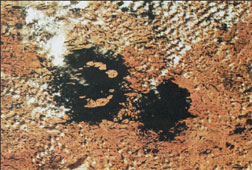Mass Extinctions
Mass Extinctions
When we study evolutionary change on an even larger timescale, we observe periodic events in which large numbers of taxa go extinct simultaneously. These events are called mass extinctions (see Figure 6-32). The most cataclysmic of these extinction episodes happened about 225 million years ago, when at least half of the families of shallow-water marine invertebrates, and fully 90% of marine invertebrate species disappeared within a few million years. This event was the Permian extinction. The Cretaceous extinction, which occurred about 65 million years ago, marked the end of the dinosaurs, as well as numerous marine invertebrates and many small reptilian taxa.
The causes of mass extinctions and
their occurrence at intervals of approximately
26 million years are difficult to
explain. Some people have proposed
biological explanations for these periodic
mass extinctions and others
consider them artifacts of our statistical
and taxonomic analyses. Walter
Alvarez proposed that the earth was
periodically bombarded by asteroids,
causing these mass extinctions (Figure
6-34). The drastic effects of such
bombardment of a planet were
observed in July 1994 when fragments
of Comet Shoemaker-Levy 9 bombarded
Jupiter. The first fragment to hit
Jupiter was estimated to have the force
of 10 million hydrogen bombs. Twenty
additional fragments hit Jupiter within
the following week, one of which was
25 times more powerful than the first
fragment. This bombardment was the
most violent event in the recorded history
of the solar system. A similar bombardment
on earth would send debris
into the atmosphere, blocking sunlight
and causing drastic changes of climate.
Temperature changes would challenge
ecological tolerances of many species.
Alvarez’s hypothesis is being tested in
several ways, including a search for
impact craters left by asteroids and for
altered mineral content of rock strata
where mass extinctions occurred.
Atypical concentrations of the rareearth
element iridium in some strata
imply that this element entered the
earth’s atmosphere through asteroid
bombardment.
Sometimes, lineages favored by species selection or effect macroevolution are unusually susceptible to mass extinction. Climatic changes produced by the hypothesized asteroid bombardments could produce selective challenges very different from those encountered at other times in the earth’s history. Selective discrimination of particular biological traits by events of mass extinction is termed catastrophic species selection. For example, mammals survived the end-Cretaceous mass extinction that destroyed the dinosaurs and other prominent vertebrate and invertebrate groups. Following this event, mammals were able to use environmental resources that previously had been denied them, leading to their adaptive radiation.
Natural selection, species selection, effect macroevolution, and catastrophic species selection interact to produce the macroevolutionary trends that we see in the fossil record. Studies of these interacting causal processes have made modern evolutionary paleontology an active and exciting field.
When we study evolutionary change on an even larger timescale, we observe periodic events in which large numbers of taxa go extinct simultaneously. These events are called mass extinctions (see Figure 6-32). The most cataclysmic of these extinction episodes happened about 225 million years ago, when at least half of the families of shallow-water marine invertebrates, and fully 90% of marine invertebrate species disappeared within a few million years. This event was the Permian extinction. The Cretaceous extinction, which occurred about 65 million years ago, marked the end of the dinosaurs, as well as numerous marine invertebrates and many small reptilian taxa.
 |
| Figure 6-34 Twin craters of Clearwater Lakes in Canada show that multiple impacts on the earth are not as unlikely as they might seem. Evidence suggests that at least two impacts within a short time were responsible for the Cretaceous mass extinction. |
Sometimes, lineages favored by species selection or effect macroevolution are unusually susceptible to mass extinction. Climatic changes produced by the hypothesized asteroid bombardments could produce selective challenges very different from those encountered at other times in the earth’s history. Selective discrimination of particular biological traits by events of mass extinction is termed catastrophic species selection. For example, mammals survived the end-Cretaceous mass extinction that destroyed the dinosaurs and other prominent vertebrate and invertebrate groups. Following this event, mammals were able to use environmental resources that previously had been denied them, leading to their adaptive radiation.
Natural selection, species selection, effect macroevolution, and catastrophic species selection interact to produce the macroevolutionary trends that we see in the fossil record. Studies of these interacting causal processes have made modern evolutionary paleontology an active and exciting field.




